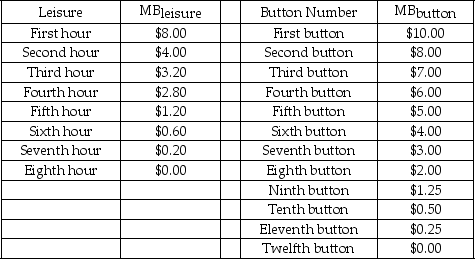Multiple Choice
Scenario: This problem applies the principle of optimization covered in Chapter 5 to the problem of choosing how many hours to work. Paul has to decide how many hours to work per day. His boss is willing to give Paul whatever hours Paul wants up to 8 hours. All else being equal, he would rather not work, that is, Paul has positive marginal benefit from each hour of leisure. But he is an avid collector of presidential campaign buttons. The more leisure he takes, the fewer buttons he can afford. So Paul faces a trade-off between leisure and buttons. Each button costs $1.00. The table below shows Paul's marginal benefits from leisure (MBlₑᵢsᵤᵣₑ) and buttons (MBbᵤttₒn) .

-Refer to the scenario above.If the hourly wage is $1.00,what is the maximum possible number of buttons Paul can afford?
A) 8 buttons
B) 6 buttons
C) 4 buttons
D) 2 buttons
Correct Answer:

Verified
Correct Answer:
Verified
Q60: Which of the following statements is true?<br>A)
Q61: Other things remaining the same,which of the
Q62: The following figure depicts a specific firm's
Q63: Takashi,an Asian,and Sally,a Caucasian,apply for a job
Q64: Non-paying activities in economics are referred to
Q66: Without any change in the supply of
Q67: Scenario: A small apple orchard operates in
Q68: Differentiate between taste-based discrimination and statistical discrimination.
Q69: The following figure depicts an individual's supply
Q70: Meryl works 10 hours a day in